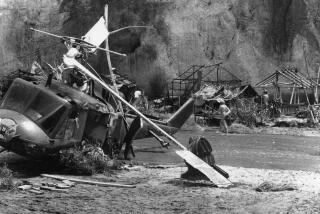A look inside Hollywood and the movies. : ALMOST FINAL CUT : Making and Marketing ‘Alive’: A Studio and Director Deal With, uh, Cannibalism
Question: How do you market an inspirational movie about stamina and courage, the heroic content of which threatens to be overshadowed by an already notorious five-minute scene dealing with cannibalism?
If you’re Touchstone Pictures’ marketing mavens, you turn up the inspirational aspect and all but ignore the grisly feast.
That, it seems, is how the studio has decided to sell their upcoming “Alive,” the Frank Marshall-directed dramatization of the infamous, deadly 1972 Andes plane crash. Starring Vincent Spano and Ethan Hawke, the film--which filmmakers expect to receive a PG-13 rating--opens Nov. 6.
According to sources, the marketing folk at Touchstone are squeamish about the cannibalism in the film and have gone out of their way to avoid mentioning or even hinting about it in the movie’s upcoming promotional campaign.
An advance peak at the “Alive” poster clearly sums up the studio’s careful marketing approach to the movie, which is being sold as a heartfelt action-adventure film that contains loads of male bonding. The emphasis is on the heroic bravery of the 16 Andes survivors, not on their survival techniques.
The poster, dominated by a washed-out photo, shows three of the survivors celebrating their rescue under the ambiguous caption “they were ordinary young men driven to the very limits of human endurance.” A smaller photo shows three men hiking down a mountainside for help under the title “Alive.”
Touchstone representatives refused to discuss the film, The Scene, or their marketing approach. Director Marshall, however, who this week was finishing scoring the movie, discussed his project and said that he didn’t think Disney was skirting the cannibalism material at all.
“The trailer, in fact (which debuts in theaters this week), is built around that dilemma,” he said.
Marshall admits, however, that while the movie’s cast discusses their survival techniques in the trailer, they do not implicitly mention what those techniques are. “And that’s only because of the ratings board,” he said.
An earlier cut of the trailer, according to Marshall, had the survivors somewhat graphically discussing the horrible dilemma of having to eat the dead to survive. But the Motion Picture Assn. of America’s ratings board demanded that the specifics be cut if the trailer was to receive a G-rated for-all-audiences approval.
“I do admit this is going to be a challenge, getting people over the aspect of the story that is already quite well-known, and that’s what the campaign is about,” said Marshall. “You mention the book and all people remember is the rugby team that ate each other. But actually, what the story is really about is emotion and spirituality. You start with a plane crash and evolve to show those boys on the side of a mountain for 72 days. They overcome many obstacles, and the dilemma about whether to eat the only available food to survive is only one of them. The movie is about coming together.”
Marshall is quick to distance his film from the Allan Carr-produced “Survive!,” the 1977 quickie that covered similar dramatic terrain and was as shocking exploitative as his 1988 Oscar show. “That movie,” says Marshall, “was all about the eating and not much more.”
“Alive” touches on this aspect quickly in one scene, which took a day to shoot. One person close to the production who has seen the film--and thus The Scene--says “It looks like they’re eating chicken.”
“Actually,” says Marshall, “it was pork.”
The director, it seems, did research to find out what animal fat layers most closely resembled that of a dissected human.
One industry marketing source questioned Touchstone’s approach to the marketing of the film. “The problem here is what if uninformed people who know nothing about this story show up and the cannibal material is dumped in their lap without any advance warning? Not everybody watches ‘Entertainment Tonight’ you know. I think not even hinting about it is a helluva push. But that’s Disney for you.”
Another competing studio marketing executive, however, supported Touchstone’s approach. “It’s not a horror film, so why market it as one? I think their campaign is absolutely correct.”
One Disney executive defended the studio’s promotional take on the movie and bristled at the idea that the campaign for “Alive” was a misleading milquetoasty cover-up. “We’re not ignoring the cannibal aspect, we’re just not sensationalizing it. I mean, what--you think we’re going to put out a one-sheet that shows people eating bodies? Riiiiiight .”
More to Read
The biggest entertainment stories
Get our big stories about Hollywood, film, television, music, arts, culture and more right in your inbox as soon as they publish.
You may occasionally receive promotional content from the Los Angeles Times.










